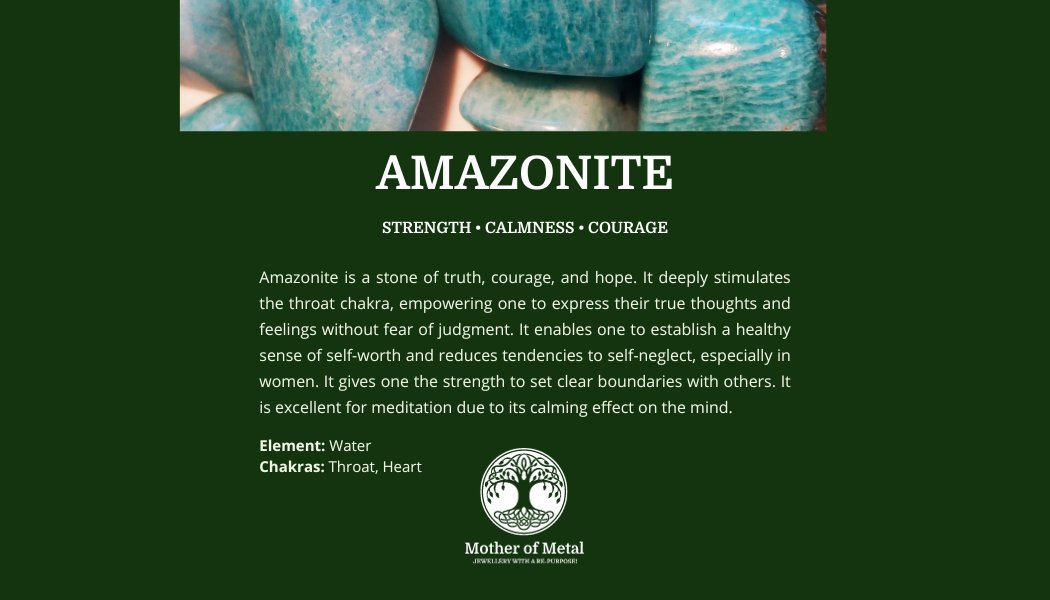
All About Amazonite!
Share
Amazonite, a stunning gemstone with a captivating blue-green or aqua hue, belongs to the feldspar mineral group and is made up of potassium aluminum silicate. Its remarkable coloration has made it a favored option for jewelry and decorative pieces throughout history. Here are some essential features and fun facts of Amazonite:
- Color and Appearance: Amazonite typically displays a range of blue-green to greenish-blue hues, often resembling the colors of tropical waters. This vivid coloration is due to the presence of trace elements such as lead and copper. Amazonite can exhibit a variety of shades within this color range, from pale pastel blues to deeper and more intense greens. Russian Amazonite is perhaps the most vivid of all!
-
Origin: The name "Amazonite" is derived from the Amazon River in South America, but the gemstone is not actually found in the Amazon basin. It is primarily mined in various locations worldwide, including Brazil, Russia, Madagascar, and the United States (Colorado and Virginia). Russian Amazonite, often called "Amazon stone," is particularly renowned for its deep green color and fine quality. The name "Amazonite" for the gemstone has an interesting history and is somewhat of a misnomer. It is not directly related to the Amazon River or the Amazon rainforest, as one might assume. Instead, its name is believed to be associated with an ancient legend and a historical mix-up.
The name "Amazonite" is thought to have originated from a legend about the Amazon women warriors of Greek mythology. According to the legend, these formidable female warriors lived in an area that was believed to be rich in greenish-blue stones. When European explorers and adventurers in the 16th and 17th centuries explored South America and came across greenish-blue gemstones, they mistakenly associated them with the Amazon women and named the stone "Amazonite."
In reality, the gemstone they discovered in South America was likely not Amazonite but rather other minerals like various forms of green microcline feldspar or even turquoise, which can be found in parts of the region. The association with the Amazon women warriors and the subsequent naming of the gemstone appear to be a case of misidentification and historical confusion.
Despite the misnomer, the name "Amazonite" has endured and become the widely accepted term for this beautiful blue-green gemstone. The legend and historical mix-up have contributed to the stone's mystique and allure over the centuries.
- History and Symbolism: Amazonite has a rich history, with archaeological evidence suggesting its use in jewelry and amulets by ancient civilizations such as the Egyptians, Greeks, and Mesopotamians. It has been associated with calmness, harmony, and balance, and is believed by some to have healing properties, both physically and emotionally. It is often considered a stone of truth, communication, and self-expression.
- Metaphysical Properties: In metaphysical and holistic practices, Amazonite is believed to have various positive attributes. It is thought to promote balance and harmony, enhance communication skills, and soothe emotional trauma. Some people also use it for its potential to alleviate stress and anxiety.
- Jewelry and Decorative Use: Amazonite is a popular choice for jewelry, including earrings, necklaces, bracelets, and rings. Its attractive color makes it a fashionable gemstone, especially in bohemian and contemporary designs. Additionally, Amazonite is used for carving and crafting decorative items such as beads, figurines, and ornamental objects.
- Care and Maintenance: Amazonite is relatively soft compared to some other gemstones, with a hardness rating of 6 to 6.5 on the Mohs scale. This means it can be susceptible to scratches and damage, so it's important to handle it with care and avoid exposing it to harsh chemicals. Cleaning should be done with mild soap and warm water, and ultrasonic or steam cleaning is generally not recommended.
Amazonite is a mesmerizing gem with a rich history and unique properties. Its soothing blue-green colors and metaphysical significance make it highly valued. Embrace its beauty and symbolism by adding it to your collection.
